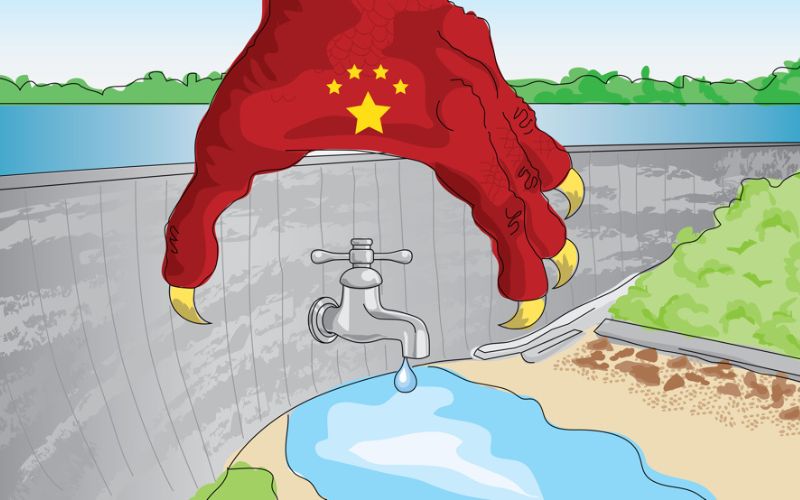
Figure 1: Via its 11 megadams on the upper Mekong, Chinese engineers can turn the river on and off like a tap, thus weaponising the river.
By Michael Buckley
World Rivers Day is celebrated on the fourth Sunday in September, which this year falls on September 24. ‘Celebrated’ is perhaps not the best choice of phrasing, as many rivers around the world are in dire straits — under siege from threats ranging from megadam-building to plastic pollution. The following article was originally published in the journal Mekong Review, August 2023 issue. The article has been modified and extended, with Tibet focus added, plus lots of graphic illustration.
A sordid saga of greed, corruption, desperate despots and out-of-control dam-building corporations — propelling the rapid demise of Asia’s greatest river….
Yunnan, Southwest China
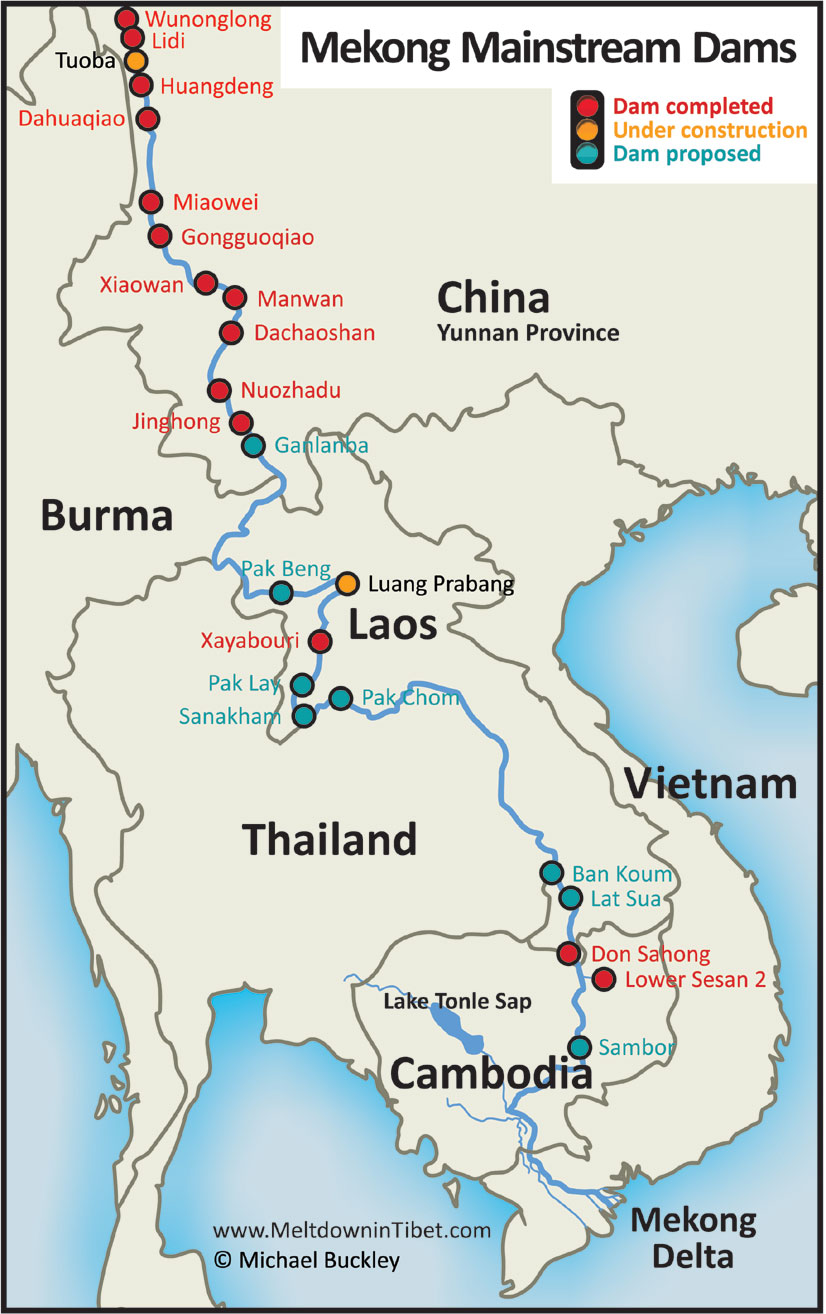 Figure 2: The status of megadam building on the Mekong as of mid-2023.
Figure 2: The status of megadam building on the Mekong as of mid-2023.
CHINA has tapped heavily into the Mekong river with megadams that are slowly strangling this vital lifeline of southeast Asia. Through construction of 11 megadams on the Mekong mainstream in Yunnan, China has generated over 21 GW of hydropower, which is equivalent to the output of the Three Gorges Dam, by far the biggest dam on the planet. Not just damming the Mekong, but other rivers sourced in Tibet—the biggest water heist in recorded history.
HH Dalai Lama sums the situation up:
“Tibet has been regarded as the ‘Water Tower of Asia’ with majority of the major rivers originating from Tibetan glacial reserves, most of which are now at risk due to global warming as well as rampant damming of rivers by China affecting downstream countries adversely.”
China desperately needs both power and water, so these megadams have solved that problem. Dams give the potential of diverting water for mining, industrial use and for agriculture. There are several engineering plans on the drawing board.
But in the process, China has created an even bigger problem: slowly strangling the Mekong as a free-flowing river for everything—and everyone—that depends on the river in the five nations downstream: Myanmar, Laos, Thailand, Cambodia and Vietnam. That amounts to over 70 million people, including Tibet and Yunnan within the borders of China.
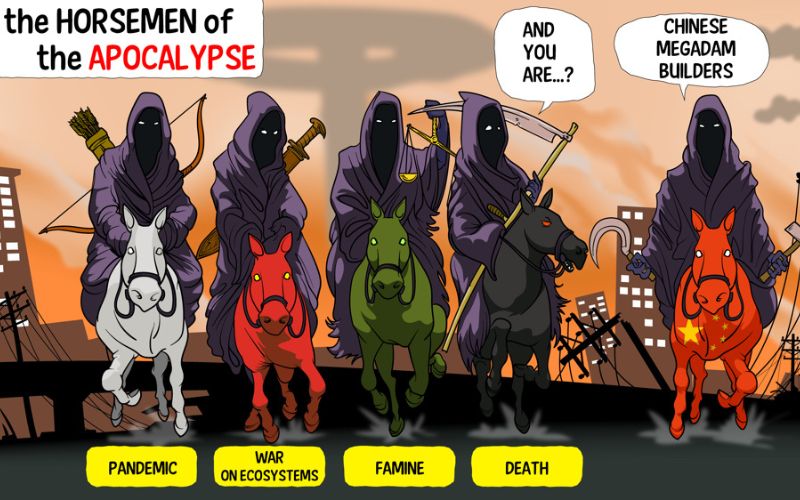 Figure 3
Figure 3
The chief impact of megadams is not just concerning the distruption of the water-flow. Megadams block the flow of nutrient-rich sediment, trapped in massive dam reservoirs. And megadams block migration and spawning for larger fish species. The Mekong is second only to the Amazon in diversity of fish species.
These are not small dams. They are monster-sized dams. Two dams —Xiaowan at 4200 MW output and Nuozhadu at 5850 MW output — combined have an output of 10 gigawatts, which is enough to power up a small nation in Europe. Xiaowan Dam is 292 metres high—roughly the height of the Eiffel Tower. From the base up, Xiaowan is roughly twice the height and width of the Potala Palace. Why such overkill on the Mekong in remote parts of Yunnan? Simple answer: most of the power is exported to industrial hubs in China via Ultra-High Voltage (UHV) power lines, which have range up to 3,000 kilometres. China is in a position to divert water from the Mekong at its whim—for drinking water, and to feed agriculture or for mining purposes.
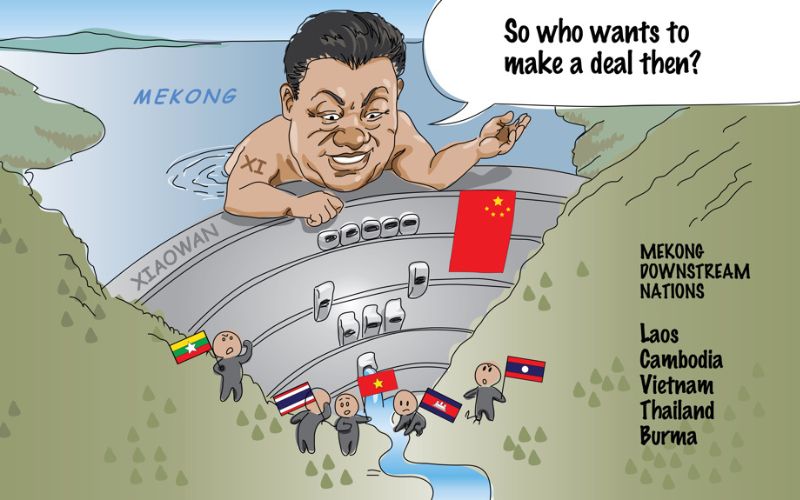 Figure 4: From the base up, the colossal Xiaowan Dam on the Mekong is twice the height and width of the Potala Palace.
Figure 4: From the base up, the colossal Xiaowan Dam on the Mekong is twice the height and width of the Potala Palace.
Actually, for the downstream nations, more dangerous than the dams is the massive water storage behind them. China in effect controls the Mekong like a tap through its 11 megadams. It can turn the Mekong on or off at its whim. This gives China the power to weaponize water.
The June 5, 2023, blowing up of Nova Kakhovka Dam in southern Ukraine resulted in thousands of refugees, flooded farms, dead fish washed up, and cutting off drinking water. The dam stored over 18 billion cubic metres of water—most of which was suddenly released. By deliberately blowing up the dam, Russia crossed a big red line: the line of Ecocide.
China has already crossed that red line. Not by dam breach but by suddenly unleashing of large amounts of water from massive reservoirs. After a huge earthquake in Sichuan in May, 2008, Chinese authorities — fearful of cracks developing in megadams — released a deluge of water from three dams on the Mekong. They gave no notice to the downstream nations, and Thailand suffered its worst flood for four decades.
Let’s look at some simple math here: Xiaowan Dam on the Mekong stores over 15 billion cubic metres in its reservoir. Downstream on the Mekong in Yunnan sits Nuozhadu Dam, with over 23 billion cubic metres of water storage. Combined, these two megadams have double the reservoir water storage of Nova Kakhovka Dam.
Laos, the Battery of Asia
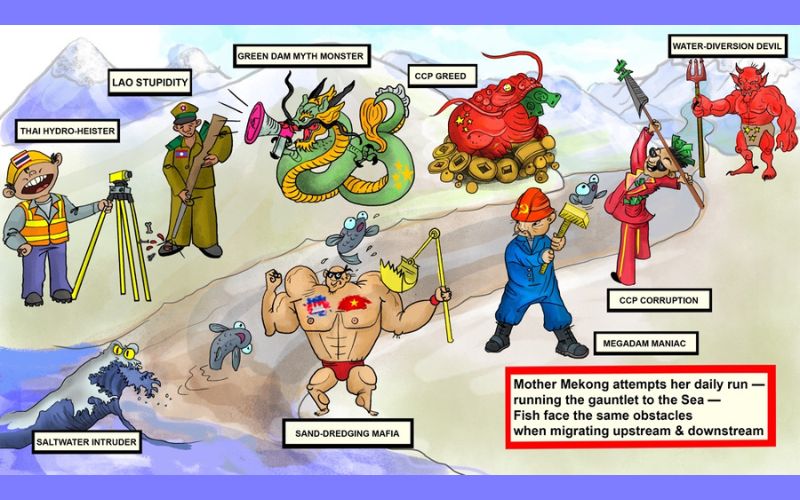 Figure 5: Monsters of the Mekong. Graphic by Isabel Arnaud.
Figure 5: Monsters of the Mekong. Graphic by Isabel Arnaud.
The news does not get any better downstream on the Mekong. This is due to highly repressive regimes of Laos, Myanmar, Cambodia and Vietnam not respecting the river—and silencing those who do respect it. All four nations are run by despots or despotic regimes. Laos, Myanmar and Cambodia are largely under the thumb of China—acting like vassal states.
Laos has declared its ambition to become the Battery of Asia, via building of scores of megadams and exporting the resulting hydropower. This plan has back-fired. Dams are expensive to build and Laos defaulted on loans from China, which promptly took over part of the electrical grid of Laos. Along with neo-colonial land grab in the form of long leases on Chinese enclaves in Laos.
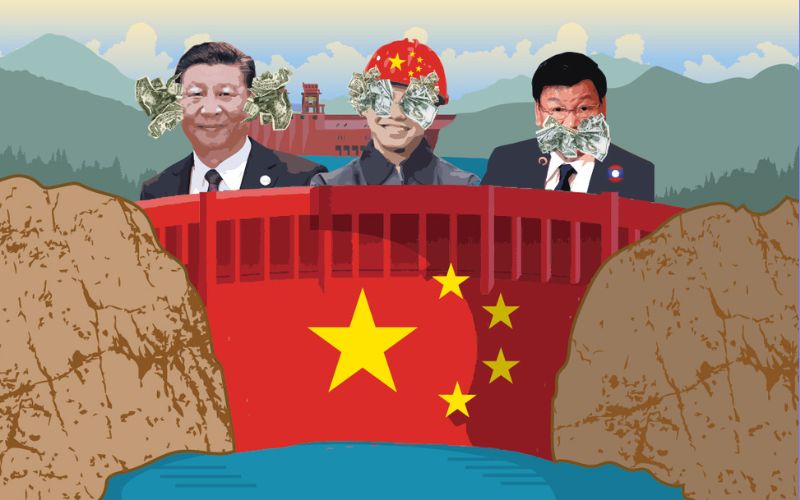 Figure 6
Figure 6
The latest signs of corruption, greed, stupidity and dictatorship are evident in the initial building of Luang Prabang Dam, which lies just upstream from the World Heritage Site of Luang Prabang. This dam is being built by CH. Karnchang from Thailand. Laos does not need this dam (most power slated for export to Thailand). Thailand does not need it (currently has an over-supply of power). So why build a dam that will probably destroy a famous World Heritage Site downstream? There is a precedent, in Yunnan: the Three Parallel Rivers World Heritage Site, spanning Mekong, Salween and Yangtse. Ludicrously, the rivers themselves not part of the World Heritage Site. After gaining World Heritage Site status, Chinese engineers promptly set about building megadams on the Mekong and the Yangtse in this location.
Corporations like CH.Karnchang make extraordinary claims that their dams do not impact the river or the fish, but cannot explain how, shortly after the inauguration of the 1285-MW Xayaburi Dam in 2019, the Mekong changed colour downstream—turning blue-ish from lack of sediment.
Sinohydro, China’s largest overseas dam-builder, destroyed an entire river basin on the major Mekong tributary known as the Nam Ou with a cascade of five dams. At the far south of Laos, Sinohydro built Don Sahong Dam, which is a small dam but blocks an important channel for migration of larger species such as Mekong dolphins (now functionally extinct in Laos).
Threatening food security in Cambodia
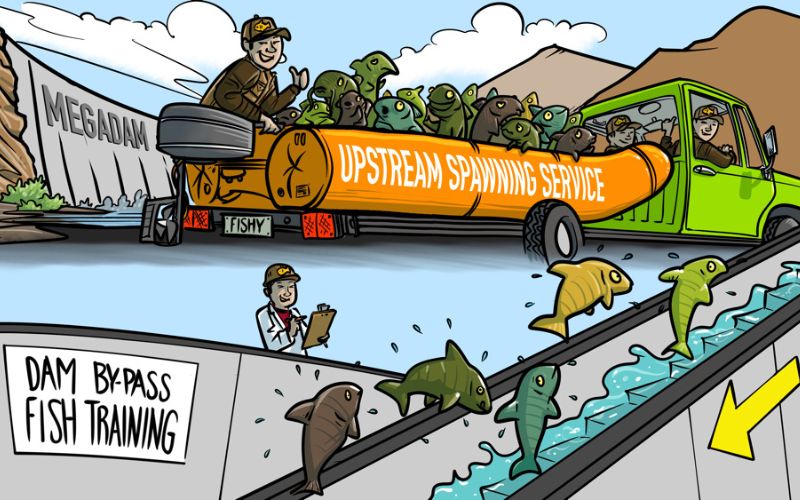 Figure 7: None of the Mekong megadams make allowance for the passage of migrating fish, except for Xayaburi Dam in Laos (maybe). Graphic by Franky Nieves.
Figure 7: None of the Mekong megadams make allowance for the passage of migrating fish, except for Xayaburi Dam in Laos (maybe). Graphic by Franky Nieves.
Around the corner, downstream in Cambodia, sits Lower Sesan 2 Dam, built on a major Mekong tributary. At 420 MW output, this is the largest dam in Cambodia, and built by Huaneng (main dam builder on Mekong in Yunnan). Fishing in Cambodia provides 70 percent of protein intake. Why would Cambodia shoot itself in the foot by building a large dam here that threatens fish migration? Short answer: Cambodian dictator Hun Sen is in bed with Chinese dictator Xi Jinping. This cozy relationship breeds corruption on a large scale.
Acting as a back-up overflow system for the Mekong, Lake Tonle Sap is the richest fishing ground in Cambodia. Or used to be. Figures are hard to come by, but the fish catch has plummeted over the last decades. The larger migrating fish species have disappeared from Lake Tonle Sap and many fishing families are abandoning the trade.
Mak Sithirith, a Cambodian researcher, says the flood pulse of the Mekong is today very weak: “Mekong River Basin is like a human body with small and large rivers as blood vessels, and Tonle Sap Lake as the heart. Therefore, any acts of humans to block blood vessels or cuts any parts of the body by dams or other infrastructure will affect the heartbeats of the Mekong. If the heart stops, the ecosystem will collapse, and it will affect the livelihoods of millions of people in the Mekong.”
Why the Mekong Delta is Falling Apart
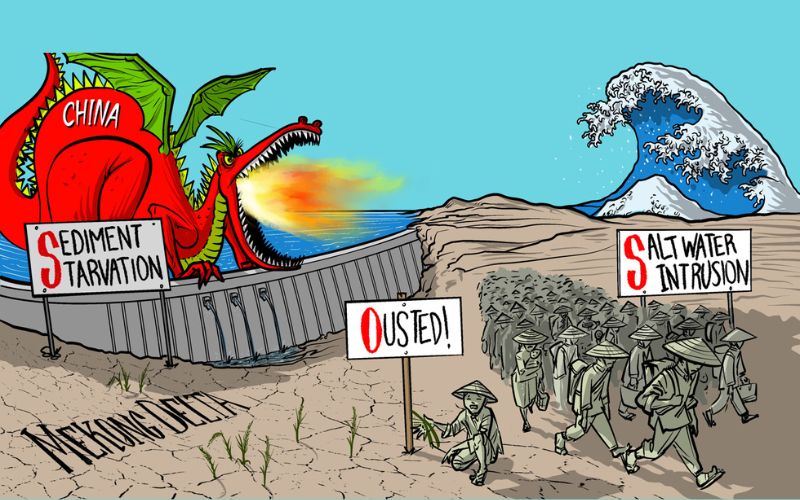 Figure 8: Vietnam’s Mekong Delta is literally falling apart. Graphic credit: Franky Nieves.
Figure 8: Vietnam’s Mekong Delta is literally falling apart. Graphic credit: Franky Nieves.
The biggest impact of all this is felt at the tail-end of river.
The Mekong Delta is the rice basket of Vietnam, providing over 40 percent of its rice, a very water-intensive crop. But the water from the Mekong is irregular (due to droughts) and farmers mostly rely on tapping into groundwater. Which is causing the slow sinking of the Mekong Delta.
The Mekong Delta is witnessing ecosystem collapse. Which is visible in the form of river-bank collapse, where entire houses and roads are swept away in the river. This is mainly due to sediment starvation (lack of sediment due to blockage by upstream dams). By definition, a delta is made from nutrient-rich sediment. The upstream dams are slowly but surely strangling the Mekong Delta for sediment. Adding to this, rampant groundwater extraction in the Delta and rampant sand-dredging from the Mekong branches for the construction industry.
Shifting Sands
Vietnam and Cambodia officially banned sand exports from the Mekong River in 2009 and 2017, respectively. Yet on the internet, Mekong River sand is advertised in orders from 20,000 to 200,000 tonnes. Large loads of river-sand from Cambodia were exported to Singapore, and while Cambodia claims not to be exporting anymore, Singapore continues to record imports from the country. But the greatest consumer of sand is China. China uses more sand than the rest of the world combined. The best sand for concrete and construction is river sand.
Another Titanic threat looming in the Mekong Delta: salt-water intrusion from the sea, which will kill crops. As sediment coming downstream on the Mekong dwindles due to excessive damming, the salt-water from the sea advances. Mangroves, a natural barrier for stopping salt-water intrusion, have been cut down to make way for rice-farming and shrimp-farming in the Delta.
Dr Le Anh Tuan, from the Earth Sciences Department at Cantho University sums up the impact:
“If we do not have effective response strategies to climate change and sea level rise in parallel with the threats posed by operations from the Lancang-Mekong upstream hydropower-dams chain, in the worst case scenario to the Mekong Delta by 2050, there may be about 10 million people migrating under various forms.…”
Solutions?
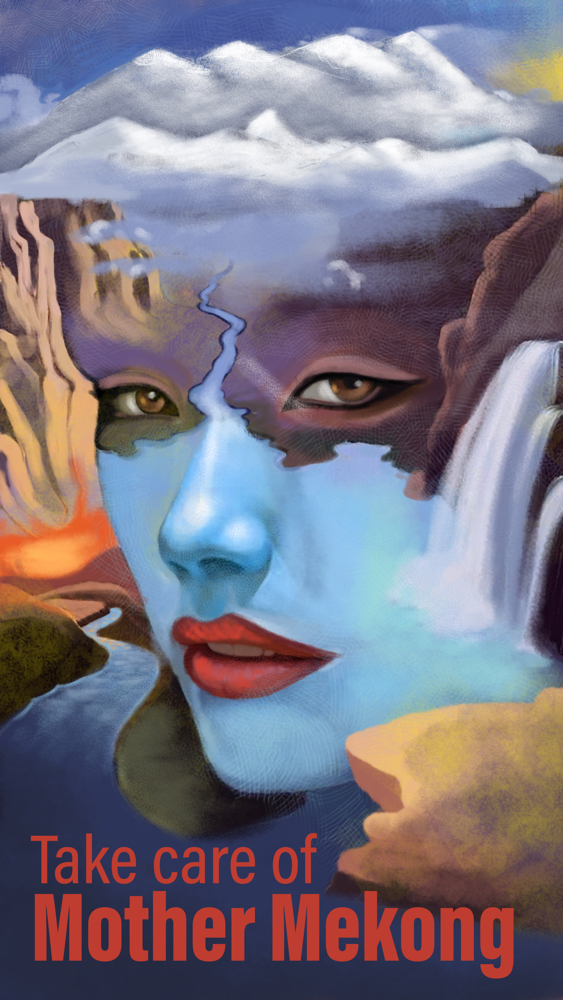
Figure 9: Mother Mekong deserves respect. Graphic by Isabel Arnaud.
So where does this end? Looks like the Mekong of the future will no longer be a river but a series of lakes. In terms of saving the Mekong, an obvious solution would be a moratorium on all dam-building along the Mekong mainstream and Mekong tributaries. But none of the major players — China, Laos and Thailand— seem interested.
In fact, things promise to get much worse. China plans to build a dozen more dams in Tibet. Laos has another seven dams on the Mekong mainstream on the drawing board — half of those Chinese-backed, and half backed by Thailand. And then there are the tributary dams: large numbers of those.
For potential solutions, the UN has proved pretty useless. China claims complete sovereignty over its upstream ‘ownership’ of the Mekong (and other rivers), and is not signatory to the UN Watercourses Convention, which lays out guidelines for sharing transboundary rivers. The UN World Heritage Committee has proved useless, not stepping in to condemn China for dam construction at the Three Parallel Rivers WH site, and not doing anything about the proposed Luang Prabang Dam site in Laos. Both sites should be downgraded to World Heritage in Danger, or just removed from the WH List.
The Mekong River Commission has proved pretty useless. Neither China nor Myanmar are on board at the MRC, which makes the group ineffective in its objective of preventing the building of dams on the Mekong mainstream.
Keeping an accurate eye on the demise of the Mekong is the Mekong Dam Monitor, an online data base, with satellite imagery of the Mekong Basin. This initiative is run by the US-based Stimson Centre. China and Laos can no longer fudge the figures on dam impact. So we can all watch this crushing disaster unfold in real time.
Respect for Rivers
A better solution would be to nurture respect for rivers and the vital functions they perform, sustaining entire ecosystems. In the US and Europe, dams have been decommissioned (blown up) as they approach the end of their life-cycle (dams last about 50 or 60 years and then start to crack and crumble). In the US, the landmark Wild & Scenic Rivers Act was brought into law, protecting scenic stretches of major rivers from any exploitation—thus allowing these stretches to be used only for eco-tourism.
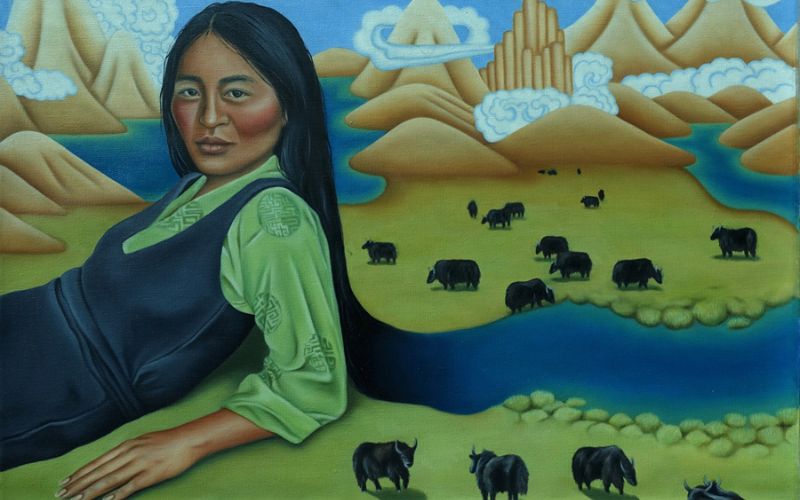 Figure 10: ‘Headwaters,’ painting by SFT activist Khenzom, gives a unique Tibetan view of rivers.
Figure 10: ‘Headwaters,’ painting by SFT activist Khenzom, gives a unique Tibetan view of rivers.
Tibetans have long revered water bodies and mountains as sacred. The only Tibetan ‘engineering’ at rivers and lakes has been the addition of colourful strings of prayer-flags. With Tibet’s Bon animist practices permeating spiritual tenets, Tibetans firmly believe in Mother Earth and, by extension, Mother River. Here’s how the Gyalwang Karmapa puts it:
“I do not see the earth as an inanimate object — a lump of stone. I think of it being alive. Sitting on the earth, I feel that everything exists. In this way, we could easily think of the earth as a goddess—a living, breathing, and constantly giving goddess.”
When we start to think of a river as a person, then the river will gain respect. Several nations (notably New Zealand) have granted rivers the same legal rights as people—in order to protect them from exploitation that damages entire ecosystems. Rivers should have the right to be free-flowing, to run from source to sea.
Graphic credits:
The graphic concepts were envisaged by Michael Buckley and drawn by various artists — mostly for use with the documentary ‘Mekong Apocalypse.’
Bionote:
Michael Buckley is an author and documentary filmmaker with a special interest in Tibet and environment issues. In 2023, he released ‘Mekong Apocalypse,’ a 55-minute documentary about the rapid demise of the Mekong river. This film takes an highly unusual approach, seeking to portray the Mekong as more of a living entity. For more about environment issues in Tibet, see: www.MeltdowninTibet.com